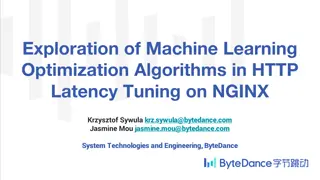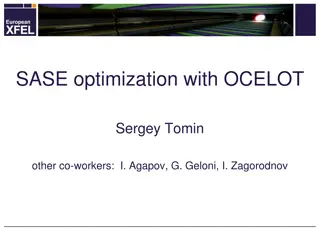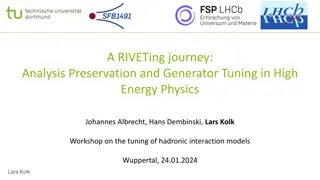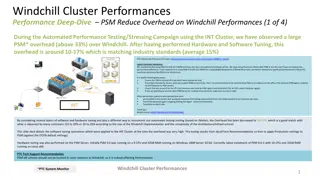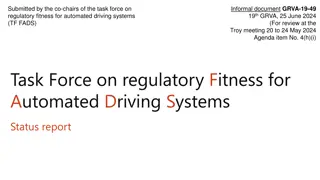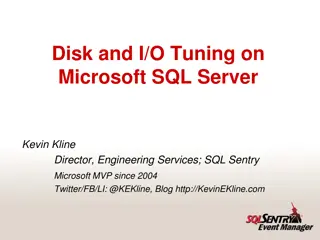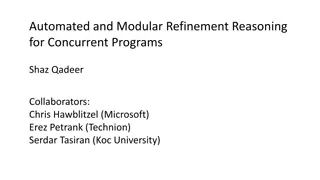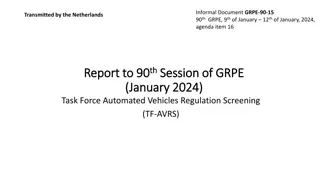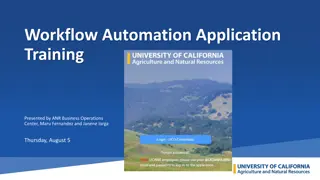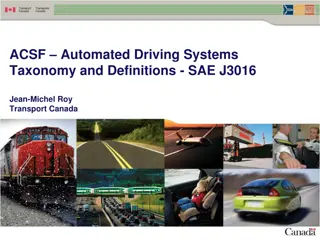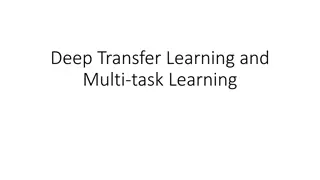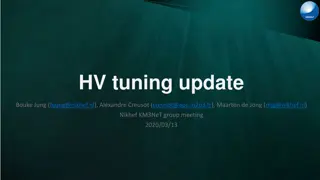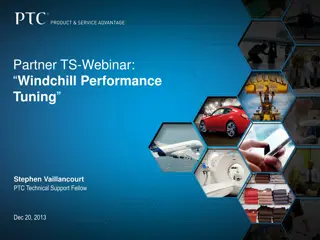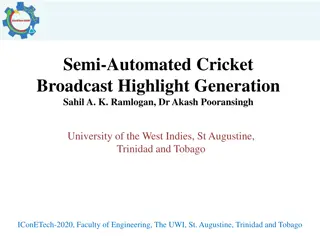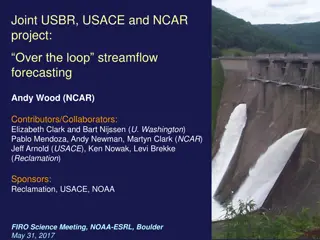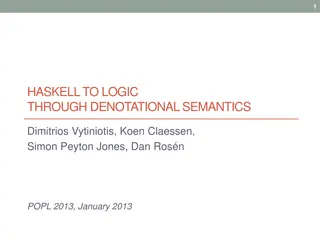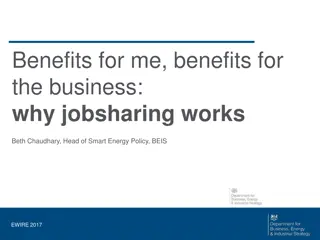Streamlining Job Performance Through Automated Tuning Processes
Explore the innovative approach of Tuning to enhance job performance while sleeping. Learn about the vision, mission, architecture, and typical conversations related to this process. Discover the significance of tuning, manual tuning phases, and Dr. Elephant's heuristic-based recommendations for optimal parameter configuration.
Download Presentation

Please find below an Image/Link to download the presentation.
The content on the website is provided AS IS for your information and personal use only. It may not be sold, licensed, or shared on other websites without obtaining consent from the author. Download presentation by click this link. If you encounter any issues during the download, it is possible that the publisher has removed the file from their server.
E N D
Presentation Transcript
TuneIn: How to get your jobs tuned while sleeping Manoj Kumar Senior Software Engineer LinkedIn Arpan Agrawal Software Engineer LinkedIn Pralabh Kumar Senior Software Engineer LinkedIn
OUR VISION Create economic opportunity for every member of the global workforce 2
OUR MISSION Connect the world s professionals to make them more productive and successful 3
Agenda Why TuneIn? How does TuneIn work? Architecture and framework features Road ahead 4
Grid Scale at LinkedIn 2008 2018 1 cluster 10+ clusters 20 nodes 1000s of nodes 5 users 1000s of active users MapReduce Pig, Hive, Spark, etc. 10000s workflows Few workflows 5
Typical Conversations Hey, this Spark job is running slowly. I will tune it to improve the run time. Manager Developer 6
Typical Conversations We have found some jobs which are consuming high resources on the cluster. I will ask my team to tune those jobs to reduce the resource usage. Hadoop Admin Manager 7
Typical Conversations Is there a way we can get this daily report 30 minutes early? I will try to tune it to reduce the run time. Client Developer 8
Why Tuning? Optimal parameter configuration: leads to better cluster utilization and thus savings reduces the execution time Default configuration is not always optimal 9
Manual Tuning PHASE 3 PHASE 1 Execute Job Come up with next parameter set Manual Tuning Process PHASE 2 Observe the Execution Metrics 10
Dr. Elephant: Heuristic based tuning Suggests tuning recommendations based on pre-defined heuristics PHASE 1 PHASE 3 Come up with next parameter set Execute Job Heuristics Based Manual Tuning No need to worry about the hundreds of counters and parameters Relies on user s initiative to use the recommendations PHASE 2 Expects some user expertise Look at the Dr. Elephant recommendations 11
Why Auto Tuning? 10000s of jobs to tune Increases developer productivity Tunes without any extra effort No expertise is expected Option of which objective function to tune for resource usage execution time etc. 13
Lets auto tune! Photo: memecreator.org 14
TuneIn Framework to automatically tune recurring Hadoop and Spark jobs Iteratively tries to reach the optimal configuration Results : 20-35% reduction in Resource Usage 15
Particle Swarm Optimization (PSO)[1] Mimics the behavior of swarm of birds searching food Starts optimization by introducing particles at random positions in the search space Source: Wikipedia Particle Swarm Optimization by J. Kennedy et al., https://ieeexplore.ieee.org/document/488968/ 16
PSO (contd.) Points of attraction: personal and global best known positions Particles converge to the region with the minimum cost function value Source: Wikipedia 17
Why PSO? Cost function is noisy PSO is gradient free and robust against noise [3] Spark and Hadoop are complex systems PSO is a metaheuristic black box optimization algorithm Fastest convergence K. E. Parsopoulos et al., Particle Swarm Optimizer in Noisy and Continuously Changing Environments, in Artificial Intelligence and Soft Computing 18
PSO Details[2] Swarm size of 3 gives the best result neither too small to cover the search space nor too big to do many first iteration random searches Good starting point is important to guide the swarm Optimizing Hadoop parameter settings with gene expression programming guided PSO by Mukhtaj Khan et al. 19
Cost function Resource usage per unit input ??????????????????? ?????? ????????? ?????? ????? ????? ???? Approximately input size invariant 20
Search Space Param 3 Parameters being tuned constitutes the search space Depends on the cost function metric Param 2 Param 1 21
Search Space Cost function: Resource Usage Pig Spark mapreduce.map.memory.mb spark.executor.memory mapreduce.reduce.memory.mb spark.executor.cores mapreduce.task.io.sort.mb spark.memory.fraction mapreduce.task.io.sort.factor spark.yarn.executor.memoryOverhead 22
Search Space Reduction Important to prevent failures Speeds up convergence Boundary parameter values e.g. ?????.????????.????? 1,10 Parameter interdependent constraints Captures the interdependence among the parameters e.g. ?????????.????.??.????.?? < 0.60 ?????????.???.??????.?? 23
Search Space Reduction Different jobs can have different optimal boundary values Boundary values are tightened on the basis of previous job execution counters 24
Avoiding over optimization Undesirable to squeeze memory so much that execution time shoots up significantly Updated cost function: ??????????????????? ?????? ????????? ?????? ????? ????? ???? + ??????? Photo: Ian Burt 25
Convergence No theoretical bound on the steps to converge Practically converges in 20 job executions TuneIn gets turned off for the job automatically on convergence 26
Results Job type Metric Reduction range Spark Resource Usage 30 - 40 % per job Pig Resource Usage 20 - 35 % per job 27
Architecture Dr. Elephant 1. Get Parameters Rest API 2. Mapper memory: 2048 Sort Buffer: 200 3. Submit Job 4. Fetch Metrics MapReduce/Spark Fetchers TuneIn Framework 28
Framework Features Generic Framework Resource usage, execution time Pig, Hive, Spark Easy integration Tuning During Regular Scheduled Runs Failure Avoidance Constraints on parameters Automatic failure handling Auto Switch Off 29
Road Ahead Heuristics based tuning Tuning for execution time Smarter tuning switch on/off Photo: www.widehdimages.com 30
References 1. Particle Swarm Optimization by J. Kennedy et al., https://ieeexplore.ieee.org/document/488968/ 2. Optimizing Hadoop parameter settings with gene expression programming guided PSO by Mukhtaj Khan et al. 3. K. E. Parsopoulos et al., Particle Swarm Optimizer in Noisy and Continuously Changing Environments, in Artificial Intelligence and Soft Computing 31
Happy tuning! Document: https://github.com/linkedin/dr-elephant/wiki/Auto-Tuning Code: https://github.com/linkedin/dr-elephant/pull/338 32
Appendix 33
Algorithms experimented with Gradient descent Brute force Simultaneous perturbation Gradient free methods Maximum likelihood region Genetic algorithm Differential evolution 34
Pig Interdependent Constraints ?????????.????.??.????.?? < 0.6 ?????????.???.??????.?? ?????????.???.??????.?? ?????????.????.??.????.?? > 768 ???.???????????????????? < 1.8 ???.??????.?? 35
Penalty Function ??????? = 3 ma???????? ???????? ????? ??????? ????? ???? 36



